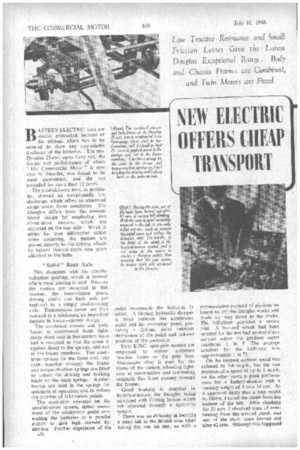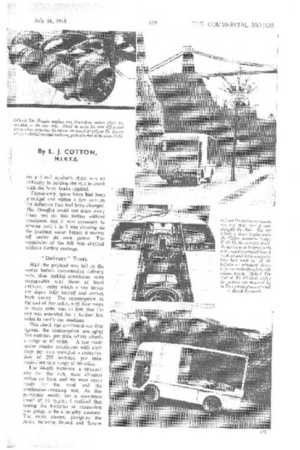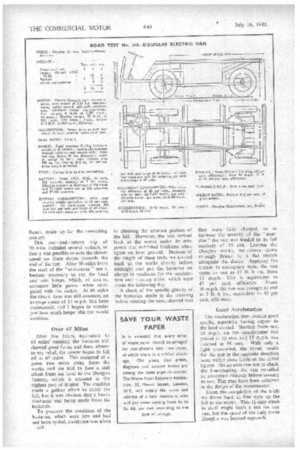NEW HICTRIC OFFERS CHEAP IMPORT
Page 28

Page 29

Page 30

If you've noticed an error in this article please click here to report it so we can fix it.
By L. J. COTTON, M.I.R.T.E.
BATTERY-ELECTRIC tests are usually protracted, because of the mileage which has to be covered to show any appreciable discharge of the batteries. The new Douglas 25-cwt. open dairy van, the design and performance of which "The Commercial Motor" is now able to describe, was found to be most economical, and the test extended for more than 12 hours.
The local-delivery tests, in particular, showed an exceptionally low discharge, which offers an abnormal range under those conditions. The Douglas differs from the conventional design by employing two direct-drive motors, which are mounted on the rear axle. Wired in series for true differential action when cornering, the motors are geared directly to the driving wheels by helical internal-tooth ring gears attached to the hubs.
" Solid " Rear Axle This dispenses with the doublereduction gearing, which is normal where bevel gearing is used. Because the motors are mounted in this manner, the transmission gears, driving shafts and • back axle are replaced by a simple load-carrying axle. Transmission losses are thus seduced to a minimum, an important feature in battery-electric design.
The combined chassis and body frame is constructed from lightgauge sheet steel in box-section form and is mounted so that the stress is applied direct to the springs, and not to the frame members. Two cantilever springs tie the front and rear axles together through the frame and torque-reaction springs are fitted to reduce the driving and braking loads on the main springs. Rubber bushes are used in the springs for quietness of operation and to reduce the number of lubrication points.
The controller operates on the parallel-series system, initial movement of the accelerator pedal connecting the batteries in a parallel circuit to give . high current for starting. further depression of the pedal reconnects the batteries in 'series. A Girling hydraulic damper is titled between the accelerator pedal and the controller panel, providing a 2-3-sec. delay between depression of the pedal and full-out position of the controller.
Twin E.D.C. split-pole motors are employed to reduce armature reaction losses on the pole face. Aluminium alloy is used for the frame of the motors, affording lightness in construction and preventing magnetic flux from passing through the frames.
Good braking is essential in battery-electrics; the Douglas being equipped with Girling brakes which are operated through a hydraulic system.
There was no difficulty in locating a steep hill in the Bristol area when taking the van on test, so with a
representative payload of pig-iron on board we left the Douglas works and made our way down to the docks. The hill-climb provided a severe trial. A by-road which had been selected for the test had several sharp corners where the gradient meter registered 1 in 5. The average gradient for the half-mile was approximately 1 in 7. On the steepest sections speed was reduced to 5-6 m.p.h., but the van maintained a speed of up to 8 m.p.h. on the other parts, a good performance for a battery-electric with a running weight of 3 tons 14 cwt. As it appeared likely that a fuse might be blown, f timed the climb from the bottom of the hill. After climbing for 50 secs. I observed signs of overheating from the control panel, and one of the main fuses burned out after 62 secs. Although this happened
on a 1-in-5 gradient, there was no difficulty in holding the van in check with the hand brake applied.
Fortunately. spare fuses had been providsd and within a few minutes
• the defective fuse had been Changed. The Douglas could not draw away from rest on this ,incline without assistance, and it was necessary to reverse until 1 in 7 was showing on the 'gradient .meter before it .started off . under its own power. The remainder of the hill was clithbed without further mishaps.
"Delivery" Tests Half the payload was left at the works before commencing delivery tests, thus making conditions more comparable with those of local delivery, under which a van leaves the depot fully loaded and arrives back empty. The consumption at the end of five miles, with four stops to every mile, was so low that the test was extended for a further five miles to verify our readings.
This check run confirmed our first figures, the consumption averaging 264 watt-hrs. per mile, which affords a range of 67 miles. A test made under similar conditions with eight stops per mile provided a consumption of 295 watt-hrs. per mile, equivalent to a range of 60 miles.
The 44-cell batteries, a standard size for the van, were changed within an hour and we were again ready for the road and the continuous running test. As this particular model has a maximum speed of 16 m.p.h., 1 realized that testing the batteries to exhaustion was going to be a lengthy business. The .route chosen, alongside the Avon between Bristol and Severn
Beach, made up for the unexciting journey.
This out and return trip of 20 miles included several inclines, so that it was possible to note the slower speed on these slopes towards the end of the test. After 50 miles from the start of the " endurance " test it became necessary to use the head and •side lamps, which, of course, consume. little power when compared with the motor. At 60 miles the circuit time was still Constant, an average speed of 13 m.p.h. had been maintained, and I began to wonder just how much longer this test would continue.
Over 67 Miles
After five hours, equivalent to 65 miles' running, the batteries still showed good form, and then, almost to my relief, the power began to fall off at 67 miles. This occurred at a point two miles away from the works and we had to face a stiff climb from sea level to the Douglas factory, which is situated in the highest part of Bristol. The machine made a gallant effort to climb the hill, but it was obvious that a heavy discharge was being made from the batteries.
To preserve the condition of the batteries, which were new and had not been cycled, assistance was given in climbing the severest portion of the hill. However, the van arrived back at the works under its own power and exhibited liveliness when again on level ground. Because of the length of these tests, we arrived back at the works shortly before midnight and put the batteries on charge in readiness for the acceleration and braking trials, which were made the following day.
A check of the specific gravity of the batteries, made in the morning before starting the tests, showed that
they were fully charged, so to increase the severity of the "exercise" the van was loaded to its full caphcity of 25 cwt. Leaving the Douglas works, we drove down through Bristol to a flat stretch alongside the docks. Applying the brakes in emergency style, the van came to rest in 17 ft. 6 ins. from 15 m.p.h. This is equivalent to 43 per, cent. efficiency. From 10 m.p.h. the van was brought to rest in 7 ft. 6 ins., equivalent to 45 per
cent. efficiency.
Good Acceleration
The acceleration tests yielded good results, especially having regard to the load carried. Starting from rest, 10 m.p.h. on the speedometer was passed in 10 secs. and 15 m.p.h. was reached in 38 secs. With only a light cross-wind, the timed results for the test in the opposite direction were within close limits of the initial figures. On an over-run test to check the free-running, the van travelled an abnormal distance before coming to rest. This may have been achieved in the design of the transmission.
Upon the completion of the trials we drove back in fine style up the hill to the works. This 1k-mile climb in itself might form a test for any van, but the speed of the fully laden Douglas was beyond reproach.












































































